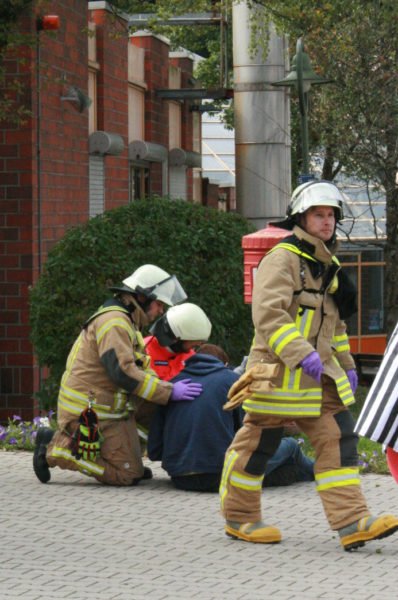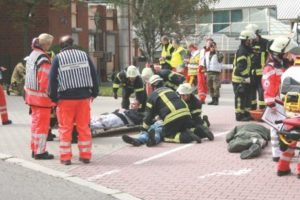
By John Reese
USAG Stuttgart Public Affairs
In an exchange program that’s the first of its kind, firefighter Lt. Matthew Cagle, Fort Jackson Fire Department, spent two weeks in September training with the U.S. Army Garrison Stuttgart FD while a garrison local national firefighter went to South Carolina.
The Ashville, N.C. native, a former Soldier with three tours in Iraq under his belt, began his career as a firefighter while stationed at Fort Hood, where he spent most of his time in service. He’s the officer of a 4-man company working either the ladder truck or heavy rescue truck. He and all of his team are certified as Firefighter-2 and as emergency medical technicians; Cagle is also qualified as a Fire Officer 3, and an inspector and instructor, level-2.
A DoD local national firefighter who works for the garrison, Matthias Künast, was exchanged to serve two weeks with the FJFD.
The program came about after years of discussion between FJFD Chief Eric Harper and Shane Crutcher, USAG Stuttgart Directorate of Emergency Services. Cagle’s chief used to be Crutcher’s deputy chief at Fort Jackson.
“Finally, since (Crutcher) came to Stuttgart, they developed a plan of exchange between American Army firefighters to come to Germany and German firefighters to work at American fire departments,” Cagle said. “The plan was to gain different information and learn different styles of tactics, administration, training; all aspects of emergency services in Germany, and for the local nationals, the same in the U.S.”

The biggest differences between German and American fire departments are mutual aid, fighting different types of structure fires and medical aid. Cagle got a close look at the different styles when he participated in Stallion Shake 2017, Sept. 16.
“Typically, in the U.S., we rely on ourselves. If mutual aid comes, its later,” Cagle explained, referring to the many local civilian emergency responders. “Another thing I noticed is that at Fort Jackson, the Military Police start clearing buildings in sections, and then we go in and start pulling the patients out as the sections are cleared. Here, the Polizei clear a building and then we go in and start taking care of triage. Also, here they have doctors who respond to the scene, which is very different from American style. Sometimes, in America, you may get a doctor, but most of the time it’s going to be paramedics and its rapid transport.”
Cagle’s advice for German firefighters who will participate in the program, is to be open minded because American firefighting is more aggressive due to the greater use of wood construction in the U.S.
“In Germany, they have more masonry, or type-2 construction – not as combustible,” Cagle said. “In America, its mostly wood, so it has a tendency to burn more freely and a fire has a chance to grow, so be open to our styles of firefighting due to our type of construction.”
The firefighter exchange program may be done more often, Cagle said, with firefighters going to other installations.
“It may even have firefighters within the U.S. go to other installations. For example, from Fort Jackson to Fort Knox,” Cagle said. “It’s a good way to learn the good and bad things, and to network and make a better fire service for our nation and our host nation.”
